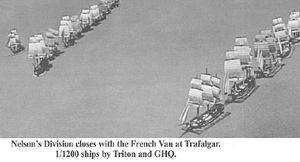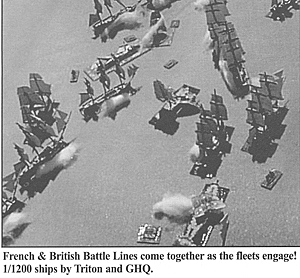
So you’ve painted up a pile of ships, and you’re ready to step into Nelson’s shoes and fight the Battle of Trafalgar - but then you realize you’d better tell the wife and family that you’ll be in the garage for the next 5 days if you want to have a chance of finishing the game!
Nelson’s Division closes with the French Van at Trafalgar. 1/1200 ships by Triton and GHQ.
There are a number of high quality Fighting Sail-era rules that excel in depicting ship-to-ship, or small squadron actions, but they usually entail such a high level of detail that makes fleet scale actions impractical to play (unless you have a week of free time). And if you’re playing a Napoleonic campaign and have a fleet action, you’re similarly out of luck.
But the Line of Battle! fleet-scale Fighting Sail miniatures system fills the fleet-scale action gap, and allows gamers to step into the role of Fleet Admiral, directing the actions of dozens of ships, not just a small squadron. Line of Battle! was written during the course of a Napoleonic campaign to solve this fundamental problem: How can you play a large free-form battle from a campaign when rival fleets clash, let alone a large historical battle such as Trafalgar, in a single afternoon?
While focused initially on the Napoleonic period, Line of Battle may be used for any Fleet action from the 17th to early 19th centuries, and lets you re-fight major actions like Trafalgar in one afternoon, and with its scenario generator and campaign rules, conduct free-form games or tie-in with campaigns. These rules may be used as a stand-alone game, or in conjunction with the strategic campaign rules in Hoplite Research’s “Corp Command.” An expanded battles and campaigns book is in the works and should be released in the Fall of 2001.
The Battle of Trafalgar - October 21, 1805
The most pivotal naval battle of the Napoleonic period, it is fair to say that Trafalgar decided the future course of the war. After an abortive attempt to descend upon the English Channel Fleet to give the Grand Armee du France the cover it needed to invade England, the combined Allied Fleet of 33 ships, under the command of Admiral Pierre Villanueve, had linked up at Cadiz and was sailing for the Straight of Gibraltar in order to enter the Mediterranean and once again turn that Sea into “Napoleon’s Pond.” Nelson intercepted the Allied Fleet with 27 Battleships off of the rocky Cape of Trafalgar and brought Villaneuve to battle.
Scenario Setup
Time of start: 8am Day Segment
Victory Conditions:
Special Rules
While players roll normally for wind during much of the day, the wind will rise to Brisk by the 4-6pm Day Segment. A Storm will sweep in after the battle, roll for ship survival and take the results into account for victory conditions. Adm. Collingsworth’s Division may take independent action, treat as a separate fleet. In the alternate organization set-up, all commands issued by the Allied fleet cost one extra Action Point.
British: 27 ships
Allied Fleet: 33 ships
Spanish: 15 Ships
The fleets were set up in their historical positions, and the game commenced. By 10:00 AM the Allied fleet was deployed into its extended ragged line with the two British division steering for them like arrows, Nelson driving the pace hard and Collingswood determined to be first to smash into the Allied line. At 11:20 the Allied player began to pepper the oncoming British divisions with ineffectual cannon-fire, aiming high in typical fashion in hopes of disabling the HMS Royal Sovereign or HMS Victory, and throwing the British battle line into confusion. Undaunted, the British battleships continued their attack, and by noon were poised to cut through the Allied fleet.
Rear Admiral Navarrete sent an interrogative to Villeneuve, requesting permission to wear the van squadron and engage Nelson’s line. Villeneuve hesitated, hoping that the gunfire smashing into the advancing British ships would force them to turn aside and present their broadsides rather than try to break the line. He hoped in vain, for Nelson won his bet with Collingswood and HMS Victory crashed through the Allied line, raking the 130-gun Santissima Trinidad and Pluton, followed through the gap by the HMS Temerarire. HMS Neptune’s captain misjudges the gap in the Allied line and careened into the Santissima Trinidad, knocking off her bowsprit and fouling the two ships together.
The rest of Nelson’s division steered as best they could around the wall of wood in front of them and attempted to follow Nelson through the Allied line of battle. Neptune and Santissima Trinidad remained locked together until 1pm in bloody hand-to-hand combat before Santissima Trinidad’s crew numbers overwhelmed the HMS Neptune’s crew and seized the ship. But this Allied victory was short lived as Santissima Trinidad came under fire from two British 74s, and broke off the action, abandoning her prize. Villeneuve’s division was thrown into chaos when Bucentaure fouled briefly with the Mont Blanc before resuming the engagement. Mont Blanc came under heavy fire, and fell off from the wind with its tiller shot away, further disorganizing the Allied line. It recovered, and made its way out of the Allied line, only to have its fore and mainmast shot away. Taking on water, Mont Blanc struck its colours to the British.
Collingswood closed with rear Admiral Magon’s division, and crashed through the Allied line while giving raking fire to the Algeciras. The HMS Royal Sovereign blundered through the gap with her foremast over the side. Three additional British lineships cut through the Allied line before the Argonauta collided with the HMS Swiftsure, foiling the rest of the British line-breakers.
Naverrete decided to wear his division about to engage Nelson, followed shortly thereafter by the unengaged ships of Le Pelley’s division. Navarrete, perhaps emboldened by some strong brandy, closed to engage in a toe-to-toe slugging match with HMS Africa, leaving his division out of command for the remainder of the engagement. His division engaged Nelson by 2pm, and a wild snaking melee ensued as the two lines coiled about in attempts to cross the other’s “T”, pounding each other at pointblank range.
At 2:30 HMS Temeraire, dismasted and in trouble, was boarded by the 100-gun Rayo, leading to a massive, chaotic melee. HMS Dreadnaught went to the aid of the HMS Temeraire, and in a fine example of upping the ante, the British and Allied players kept feeding more ships into the melee until 6 battleships (Rayo, Santa Ana, San Justo, Temeraire, Brittania and Prince) were grappled together in a grand melee that see-sawed back and forth with boarding and counter-boarding actions until the end of the engagement.
By late afternoon, Magon’s division was sorely pressed, his ships battered by Collingswood’s division - Aigle, Argonaute, and Duguay-Trouin had all struck their colours to the British. The high point of Magon’s day was when Achille battered the HMS Bellerophon, sending it reeling from the fight, and in an amazing display of gunnery, magon’s flagship dismasted the HMS Polyphemus. Rear Admiral Escano came to Magon’s aid, and forced the HMS Thunderer to strike after a heavy exchange of cannon fire - but his elation was short-lived as he came under attack from several British battleships, determined to make up for the loss of HMS Thunderer. In the ensuing exchange, Escano’s flagship, the Argonauta, was set afire and her steering shot away. Ablaze and out of control, the Argonauta careened into the San Ildefonso. HMS Dreadnaught adds to her troubles by bow-raking her, sending the fires out of control, and despite the best efforts of her crew the blaze spread to her magazine, and the Argonauta exploded in a fountain of blazing wood, and devastating the poor San Ildefonso.
With Escano gone, and hearing news of the loss of Navarrete, the stunned Gravina ordered his fleet to withdraw, and the remains of the Spanish fleet retired. The very alone and angry Villeneuve shook fist at the departing Spaniards and tried valiantly to extricate himself from the tangled battle lines, shifting his flag from the crippled Bucentaure to the Scipion. Nelson and Collingswood’s divisions came together, forming a gauntlet past which Villeneuve ran madly downwind, but to no avail -- much of the French fleet struck its colours and the by 4:00pm the battle was over. While the Allied players got away with a few more ships than historically, it was a smashing victory for the British.
All sides had great fun (which is what really counts). While it was a smashing British victory, the Allies felt they had at least escaped with a few more ships than historically and had put up a good fight. The players all agreed that had the Allies been more pro-active early in the engagement, rather than reactive (though to be fair, the Allied players were hampered by severe Command and Control problems and generally suffered from poor quality leaders with fewer command points), they might have faired better.
Admiral Villeneuve could have ordered Navarette’s division to engage early in the battle, bringing more firepower to bear on the British. Too, the player with Admiral Navarette’s division at the Allied van made a serious mistake by deliberately taking himself out of command and personally engaging a British ship in a boarding action.
Weather: Clear
Wind: Blowing Light, Direction 3
Initiative: The British hold the initiative at the Beginning of the Battle.
British: Bring the Allied fleet to battle and rout or destroy at least half the fleet
Allies: Rout or destroy half the British fleet, or escape with all Divisions intact
Ship and Officer Rosters
Admiral Horation Nelson (A) (Victory) - 13 ship division
Vice Admiral Cuthbert Collingswood (B) (Royal Sovereign) - 14 ship division
Flagship (12) x1: Victory (A)
1st/2nd Rates (10) x6: Temeraire(D), Neptune(C), Britannia(D), Prince(D), Royal Sovereign(B), Dreadnaught(D)
3rd Rates (8) x 20: Leviathan(D), Conquerer(D), Ajax(D), Agamemenon(C), Orion(D), Minotaur(D), Spartiate(D), Bellisle(B), Mars(C), Tonnant(D), Bellerophon(C), Colossus(), Achille(B), Africa(C), Revenge(C), Defiance(C), Swiftsure(D), Polythemus(D), Thunderer(E), Defence(D)
French: 18 Ships
Admiral Pierre Villaneuve (D) (Bucentaure) - 8 ship division
Admiral Charles Magon (D) (Algeciras) - 5 ship division
Admiral Dumanoir Le Pelley (E) (Formidable) - 5 ship division
Flagship (10) x1: Bucentaure (D)
3rd Rates (8) x17:Scipion(E), Intrepide(E), Formidable(D), Mont-Blanc(E), Duguay Trouin(F), Heros(E), Redoubtable(D), Neptune(E), Indomptable(D), Fougeux(F), Pluton(E), Algeciras(D), Aigle(E), Swiftsure(E), Argonaute(E), Achille(F), Berwick(F)
Vice Admiral Federico Gravina (D) (Principe de Asturias) - 5 ship division
Rear Admiral Antonio Escano (E) (Argonauta) - 3 ship division
Vice Admiral Ignacio Maria de Alava y Navarrete (D) (Neptuno) - 4 ship division
Rear Admiral Blatasar Hidalgo y Cisneros (E) (Santa Ana) - 3 ship division
Flagship (12) x1: Principe de Asturias (D)
4-Deckers (13) x1: Santisima Trinidad (E)
1st/2nd Rates (10) x2: Rayo (E), Santa Ana(D)
3rd Rates (8) x11: Neptuno(D), San Francisco de Asis(E), San Augustino (F), San Justo(G), San Leandro(F), Monarca(F), Bahama(E), Montanez(E), Argonauta(D), San Ildefonso(E), San Juan(E)
 Game Replay
Game Replay
Back to Table of Contents -- Courier #84
To Courier List of Issues
To MagWeb Master Magazine List
© Copyright 2002 by The Courier Publishing Company.
This article appears in MagWeb (Magazine Web) on the Internet World Wide Web.
Other military history articles and gaming articles are available at http://www.magweb.com